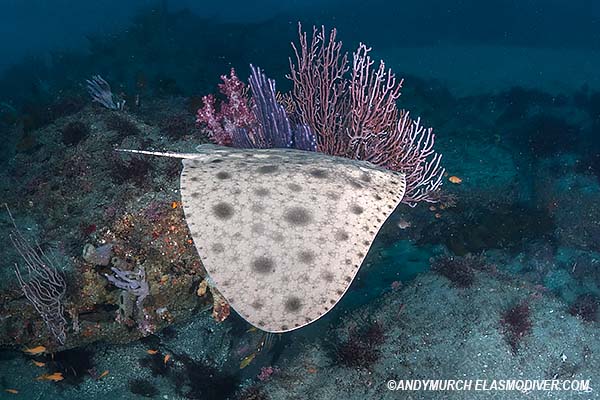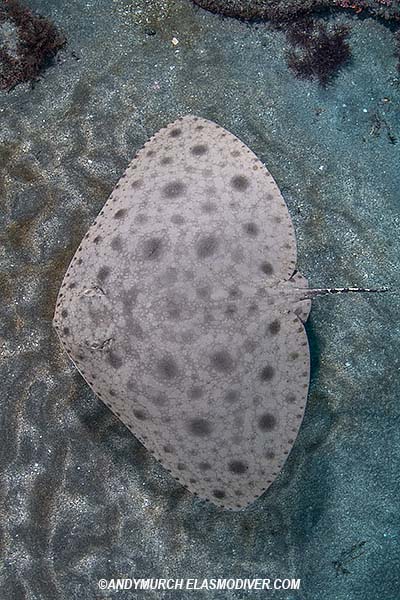|


View all available
Japanese Butterfly Ray Pictures
Common Names:
Japanese Butterfly Ray, moth ray, butterflyray.
Accepted
Scientific Name:
Gymnura japonica.
Junior Synonyms:
Gymnura bimaculata*, Pteroplatea japonica.
Family:
Gymnuridae.
Identification:
Disc width at least twice disc length. Dorsum
pale tan to dark brown with small scattered dark spots. A line of
small dark spots line the anterior margin of the disc. 20 or more
much larger dark spots spaced symmetrically across the disc. Ventrum white
or
cream. Short tail has a black broken line on top that creates a variegated
appearance.
Size:
Maximum disc width 145cm.
20-22cm at birth.
Habitat:
Sandy or muddy bays and brackish estuaries,
occasionally near
rocky
reefs.
Abundance and distribution:
Northwest Pacific and China Seas:
North and South Korea, China, Japan, Cambodia and Malaysia.
Unconfirmed reports from India. Historical records of Gymnura
japonica from Indonesia and the Philippines are now attributed
to G.zonura
Behavior:
The Japanese butterfly ray lays motionless for much of the time under a thin covering of sand.
Hunts by gliding close to the sand in order to detect small benthic
animals.
Diet:
Feeds on small benthic fishes and other
bottom dwelling animals.
Reproduction:
Ovoviviparous.
2-8 embryos. Once the unborn spiny butterfly
rays have completely used up the reserves in the yolk sac, the mother secretes
uterine milk. Long villi (filaments) grow from the uterus walls into the
embryo's spiracles. Milk can then be directed more efficiently into the embryo's
mouth and throat.
Conservation
Status: The IUCN lists the Japanese butterfly ray as data
deficient. However, the species is susceptible to a variety of gear
types, including demersal trawl, gillnet, trammelnet and setnet
fisheries throughout its range, and is known to be commercially
fished off China. Population declines are reported to have occurred
off Japan and China, but no information is currently available on
the scale of these declines or the capture of this species in
fisheries. Although the threat status of this species may be of
significant concern, insufficient information is currently available
on this species' distribution, abundance and the extent of any
declines to fully assess its status and therefore it is presently
listed as Data Deficient. Further investigation is required into
taxonomy and population trends in this species, to fully define its
range and the extent of any decline and this assessment should be
revisited once these issues are better resolved.**
Photographs:
Chiba, Japan.
Similar species:
The Japanese butterfly ray
shares parts of its range with a number of other Gymnurids including
the long-tail butterfly ray - distinguished by small light spots and
a proportionately longer tail than other butterfly rays. The
Zonetail butterfly ray has a pattern of small white spots. It has a
patchy distribution with the Eastern Indian Ocean and Western
Central Pacific off the coasts of India, Indonesia, Singapore and
Thailand.
Reaction to divers:
Remains motionless relying on
camouflage unless disturbed.
Diving logistics:
Gymnura japonica is
occasionally encountered by divers around the Chiba and Izu
peninsulas on the south side of Honshu Island, Japan. Contact Bommie
Dive Centre for more information on diving in Ito, Chiba.
Citations:
* The Taxonomic
Status of
Gymnura bimaculata
and
G. japonica:
Evidence from Mitochondrial DNA Sequences
Anglv Shen, Chunyan Ma, Yong Ni, Zhaoli Xu and Lingbo Ma
Journal of Life Sciences: January 30, 2012.
**
Ishihara, H., Wang, Y. & Jeong, C.H. 2009. Gymnura japonica. The
IUCN Red List of Threatened Species. Version 2014.3. <www.iucnredlist.org>.
|























